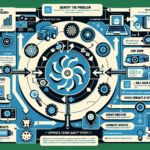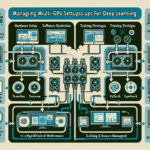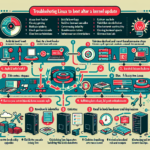Configuring NVIDIA GPU drivers for deep learning workloads on Linux involves several steps to ensure your system is ready for high-performance computations. Here’s a detailed guide:
1. Check GPU Compatibility
- Verify your NVIDIA GPU model is supported for deep learning workloads by checking compatibility with CUDA and cuDNN libraries on the NVIDIA website.
2. Prepare Your Linux Environment
- Update your Linux system to the latest version for compatibility:
sudo apt update && sudo apt upgrade - Make sure you have the necessary developer tools installed:
sudo apt install build-essential dkms
3. Install NVIDIA GPU Drivers
-
Check for the latest NVIDIA drivers:
Visit the NVIDIA Drivers Download page and identify the correct driver version for your GPU and Linux distribution. -
Remove existing drivers (if needed):
sudo apt remove --purge nvidia-* -
Add the NVIDIA repository (Ubuntu/Debian):
sudo add-apt-repository ppa:graphics-drivers/ppa
sudo apt update -
Install the recommended driver:
ubuntu-drivers devices
sudo apt install nvidia-driver-<version>
Replace<version>with the recommended or latest driver version. -
Verify driver installation:
nvidia-smi
This should display information about your GPU and the installed driver.
4. Install CUDA Toolkit
- Download the CUDA toolkit installer from the NVIDIA CUDA Toolkit page.
-
Follow the installation instructions for your Linux distribution.
-
Add CUDA to your path:
export PATH=/usr/local/cuda/bin:$PATH
export LD_LIBRARY_PATH=/usr/local/cuda/lib64:$LD_LIBRARY_PATH - Verify CUDA installation:
nvcc --version
5. Install cuDNN
- Download cuDNN from the NVIDIA cuDNN page (requires registration).
- Extract the downloaded archive and copy the files to the appropriate CUDA directory:
sudo cp cuda/include/cudnn*.h /usr/local/cuda/include
sudo cp cuda/lib64/libcudnn* /usr/local/cuda/lib64
sudo chmod a+r /usr/local/cuda/include/cudnn*.h /usr/local/cuda/lib64/libcudnn*
6. Install Deep Learning Frameworks
- Install Python and pip:
sudo apt install python3 python3-pip - Install frameworks like TensorFlow or PyTorch with GPU support:
- TensorFlow:
pip install tensorflow - PyTorch:
pip install torch torchvision torchaudio --index-url https://download.pytorch.org/whl/cu<version>
Replace<version>with your CUDA version (e.g.,cu118for CUDA 11.8).
- TensorFlow:
7. Test Your Setup
- Run a quick test to ensure the GPU is being utilized:
- TensorFlow:
python
import tensorflow as tf
print("GPUs Available: ", len(tf.config.list_physical_devices('GPU'))) - PyTorch:
python
import torch
print("CUDA Available: ", torch.cuda.is_available())
print("GPU Name: ", torch.cuda.get_device_name(0))
- TensorFlow:
8. Monitor GPU Usage
- Use
nvidia-smito monitor GPU utilization:
nvidia-smi
9. Optional: Install Docker for GPU Workloads
- Install Docker and the NVIDIA Container Toolkit for GPU-accelerated containers:
sudo apt install docker.io
sudo docker run --gpus all nvidia/cuda:11.8-base nvidia-smi
10. Troubleshooting
- Ensure secure boot is disabled in BIOS if the drivers fail to load.
- Check kernel compatibility with the driver version.
- Verify your GPU is not being used by another application.
By following these steps, you should have a fully configured NVIDIA GPU environment tailored for deep learning workloads on Linux.




